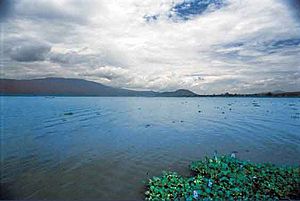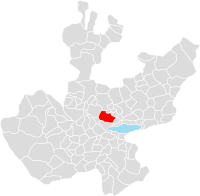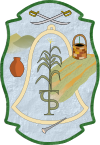Tlajomulco de Zúñiga facts for kids
Quick facts for kids
Tlajomulco de Zúñiga
|
||
|---|---|---|
|
City and municipality
|
||
 |
||
|
||

Location of the municipality in Jalisco
|
||
| Country | ||
| State | Jalisco | |
| Area | ||
| • Municipality | 674 km2 (260 sq mi) | |
| • City | 8.54 km2 (3.30 sq mi) | |
| Elevation | 1,585 m (5,200 ft) | |
| Population
(2020 census)
|
||
| • Municipality | 727,750 | |
| • Density | 1,079.7/km2 (2,796.5/sq mi) | |
| • City | 44,103 | |
| • City density | 5,164.3/km2 (13,375/sq mi) | |
| Time zone | UTC-6 (Central Standard Time) | |
| • Summer (DST) | UTC-5 (Central Daylight Time) | |
| Website | https://www.tlajomulco.gob.mx/ | |
Tlajomulco de Zúñiga is an important city and a municipality in the state of Jalisco, Mexico. It is part of the larger Guadalajara metropolitan area, located to its southeast. The municipality covers an area of about 674 square kilometers. In 2020, over 727,000 people lived in the whole municipality.
The name Tlajomulco comes from the Nahuatl language. It means "Land in the Corner."
Because it's close to Guadalajara, Tlajomulco has many factories and shops. The Guadalajara International Airport is also located here.
Contents
What Does the Name Tlajomulco Mean?
The name Tlajomulco comes from the Nahuatl words tlalli (land), xomulli (corner), and co (place). So, it means "Land in the corner."
Important Towns and Cities
What makes Tlajomulco special is that it has many large towns and cities. It's the only municipality in Mexico with seven towns that have over 25,000 people. It also has 20 towns with more than 10,000 people!
Some of the biggest towns and cities in Tlajomulco de Zúñiga are:
- Hacienda Santa Fe (with over 139,000 people)
- San Agustín (with over 49,000 people)
- Tlajomulco de Zúñiga (the main city, with over 44,000 people)
- Lomas del Sur (with over 37,000 people)
- Santa Cruz del Valle (with over 30,000 people)
A Look at Tlajomulco's History
The area where Tlajomulco is today was first settled by the Nahua peoples. In 1266, when King Tlajomulpilli was in charge, the town became very strong. It even controlled other nearby towns like Tala and Acatlán.
Tlajomulco was founded to thank some brave people who fought against the Purépecha people. In 1530, a Spanish explorer named Nuño de Guzmán arrived. He was welcomed by the local leader, Coyotl, who helped him conquer the nearby area of Tonalá. Coyotl was later baptized and changed his name to Pedro de Guzmán.
Much later, on July 27, 1939, the area was officially named Tlajomulco de Zúñiga. This was done to honor General Eugenio Zúñiga, who was from Tlajomulco. At that time, it became an important municipality.
See also
 In Spanish: Tlajomulco de Zúñiga para niños
In Spanish: Tlajomulco de Zúñiga para niños




